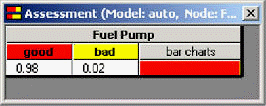Diagnosis and Troubleshooting
When your car doesn't start, what should you do?
- A) Check if your lights work
- B) Replace your fuel pump and see if that helps
Choice A) seems wiser. Why? Because checking your lights tells you much about
your car's battery, a likely cause of your problem. But that's not the whole
reason to check your lights first. Just as important, you check your lights
first because such a check is easy and inexpensive.
![[Sample of Recommendations List]](MSBNx.1.gif) �MSBNx is a tool for doing this kind of cost-benefit reasoning for
diagnosis and troubleshooting. �MSBNx is a tool for doing this kind of cost-benefit reasoning for
diagnosis and troubleshooting.
Causes and Uncertainty
You start using MSBNx by creating a model of your system. First, you create a
diagram showing what causes what. For example, in our car model, the battery
power causes the lights to on. Battery power also causes the engine to turn over
which, in turn, causes the car to start.
Second, you tell about the uncertainty in the system, giving your
probabilities for various situations. Here are some examples:
 Before you tried to start your car, how likely would you find a bad
fuel pump? In our car model we set this to 2%. Before you tried to start your car, how likely would you find a bad
fuel pump? In our car model we set this to 2%.
- If battery power is high, how likely are the lights to work? We set this to
99.9%
Third and finally, you can add cost information. In the car model, we set the
cost of checking the lights at $1. We say that fuel pumps can't be tested, only
replaced, which costs $100.
Your model of causes and effects is called Bayesian Network Network (or
sometimes Bayes' Net or Belief Network).
![[Bar chart showing probabilities of good battery]](MSBNx.2.gif) Run It Backwards Run It Backwards
Once you've created a model, you can use it for diagnosis and
troubleshooting. MSBNx evaluates your causes-to-effects model by running it
backwards from effects to causes. Given known effects, for example, evidence of
the lights working, it computes the probability of causes such as a bad battery.
It also computes the utility of further tests, for example, checking the gas
gauge. Although, MSBNx recommends which test to do next, you can do tests in any
order. As you enter new evidence, MSBNx efficiently recomputes the probability
of possible causes and the recommended order of further tests.
An extensive manual documents MSBNx.
More Information.
J. S. Breese and D.E. Heckerman. Topics in
Decision-Theoretic Troubleshooting: Repair and Experiment. Microsoft Research
Technical Report TR-96-06, 1996.
D. E. Heckerman, E. J. Horvitz, and B. N.
Nathwani. Toward Normative Expert
Systems: Part I The Pathfinder Project. Methods of Information in
Medicine, 31:90-105, 1992.
D. E. Heckerman and J. S. Breese, et al.,
Troubleshooting Under Uncertainty. Microsoft Research Technical Report TR-94-07,
1994.
D. E. Heckerman and J. S. Breese. Causal
Independence for Probability Assessment and Inference Using Bayesian Networks.
Microsoft Research Technical Report TR-94-08, 1994.
E.J. Horvitz, J.S. Breese, and M. Henrion, Decision Theory in Expert
Systems and Artificial Intelligence, Journal of Approximate
Reasoning, Special Issue on Uncertainty in Artificial Intelligence,
2:247-302, 1988.
|